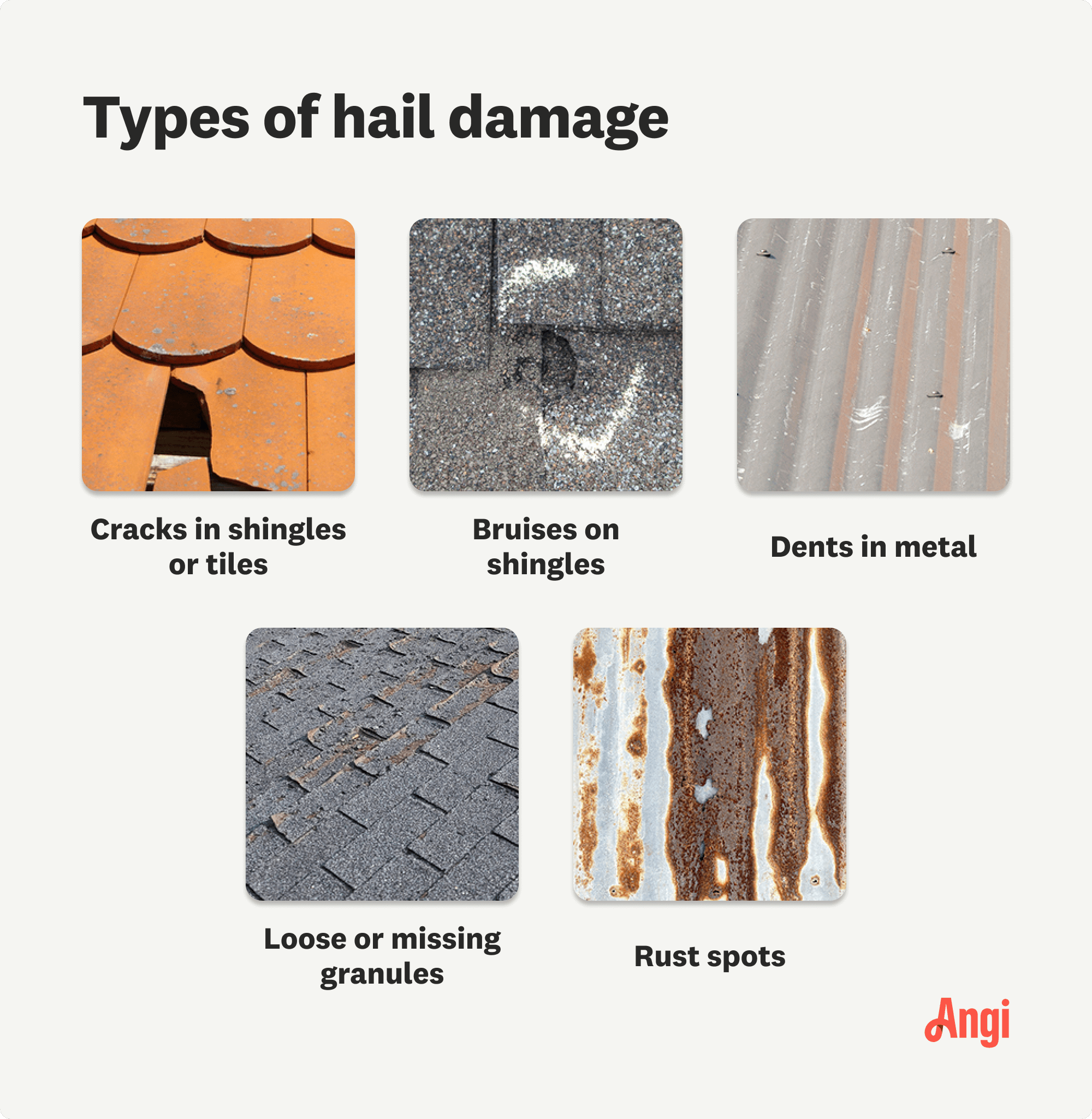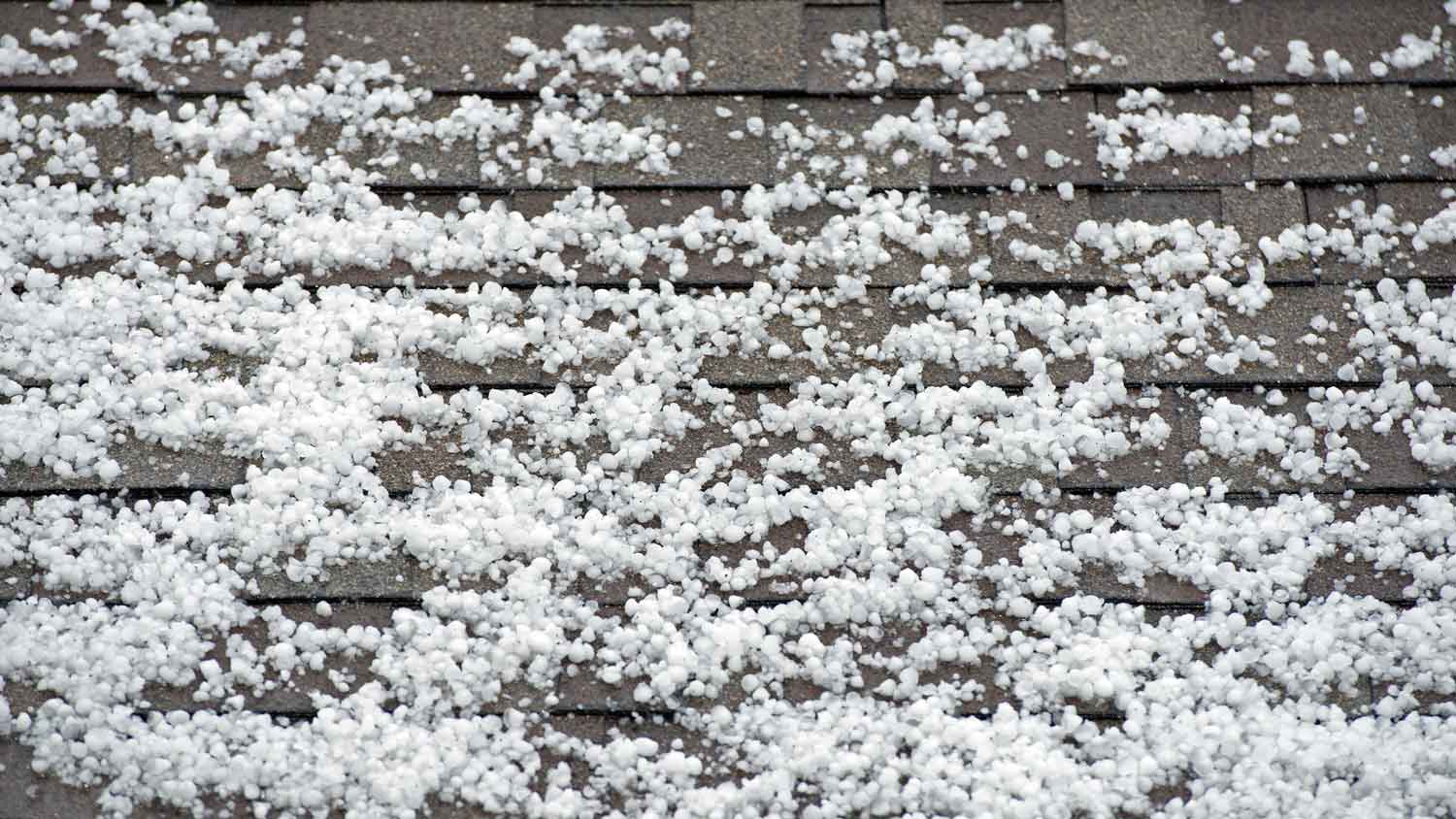Why Is Hail Damage Bad for a Roof?
Hail damage to a roof can cause rusting and leaks and may require extensive repairs


Hail can crack and bruise the shingles or tiles on your roof.
Hail can cause roof leaks, mold growth, or structural damage.
You may need to repair or replace your roof, based on the damage.
Homeowners’ insurance may cover the cost of fixing a hail-damaged roof.
A solid roof can generally take a beating during a hailstorm, even if the hail is large and accompanied by high winds. But there are times when it cannot, and that is when it is important to understand why exactly hail damage is bad for a roof. It can split and bruise your roof's shingles, paving the way for leaks, mold growth, and damage from ultraviolet light. After a storm, you may not always be able to spot hail damage on your roof, so hiring a local roof repair specialist for an inspection is often the way to go.
What Does Hail Do to Your Roof?
Hail can damage your roof in two ways. The first type of damage is easy to see upon visual inspection. If you look at your roof after a hailstorm, you may see:
Divots or dents in your roofing material
Cracks in your roof's shingles
Bruises or black blotches on the roof
Missing shingles
Rusting
Other signs of hail damage can be harder to spot. The impact of a piece of hail can crack the shingle on the underside. To see the crack, a roofing inspector would need to pick up the shingle.
When it comes to asphalt shingle roof damage, hail can also scrape away the granular coating on some types of shingles, causing them to weaken. The granules can collect in your home's gutters or downspouts. You may only notice the granules when cleaning your gutters.
What Roof Hail Damage Looks Like

Hail roof damage can take many different forms, and it affects roofing materials differently. Here are a few types of hail damage to watch for after a big storm.
Cracks in Shingles or Tiles
If hail hits asphalt shingles, clay or slate tiles, or cedar shakes, it can crack them. These cracks can allow moisture to seep through the shingles and cause water damage to the roof deck and the interior of the attic. Even if you do not see any cracks, it is possible that the hail impact cracked the underside of the shingle or tile.
Bruises on Shingles
When hail hits asphalt shingles, it can bruise them. Shingle bruises look like irregular circles where the impact caused the surface to soften and some of the granules to come loose. This compromises the integrity of the shingle.
Dents in Metal
Large hailstones can dent metal roofs. These dents are not only unsightly, but they can also be a sign that the metal is cracked and will allow moisture to get underneath the roofing material, causing problems with mold and mildew and possible structural damage.
Loose or Missing Granules
Hail can cause the granules on asphalt shingles to loosen and slide off. These granules protect the shingle, so if they are missing, the shingle is vulnerable to moisture.
Rust Spots
Hail can chip, scratch, crack, or otherwise damage the paint on a metal roof. Once the metal underneath is exposed, it becomes vulnerable to future moisture that could cause the metal roofing to rust.
How Hail Damages Different Types of Roofs

Hail causes different types of damage to different types of roofs. When inspecting your roof after a hailstorm, make note of the material type when looking for damage.
Asphalt Shingles
Asphalt shingles are one of the most popular roofing materials, so there is a good chance that they are what you have on your roof. Hail can cause the granular coating to wear off of asphalt shingles, making them weaker and more prone to sun damage. Over time, exposure to the sun's UV rays can cause significant deterioration of the shingles. The force of hail hitting a roof can also loosen asphalt shingles or cause bruises or soft spots. Loose or missing shingles make your roof more prone to leaks.
Wood Shingles
Big pieces of hail can crack wood shingles, typically along the wood grain. Hail can loosen wood shingles, making it easier for them to fall or blow off the roof. Water can then seep into your roof, damaging the structure below.
Tile and Slate Shingles
Hail can crack or chip slate or tile roofs, too. The damage can be severe enough to cause them to slide off the roof. Cracked or missing tiles or slate shingles can lead to leaks.
Metal Roofs
Pieces of hail can dent the surface of metal roofs. The hail can also make a metal roof more prone to rust, which weakens it.
Long-Term Effects of Hail Damage
Hail damage is bad news for your roof, especially if not corrected promptly. When your roof's shingles are compromised, they cannot protect your home in the way they are meant to. A hail-damaged roof is more prone to leaks and is likely to have mold or algae growth. If there are openings in the roof due to hail damage, your home may be hotter or colder than you would like, depending on the season.
How to Tell if Your Roof Has Hail Damage
After a hailstorm, there are a few things you should do to see if your roof has hail damage.
Do a visual inspection from the ground: Do you see any dents, cracks, missing or loose shingles, or bruising marks?
Check the gutters and downspouts: Are there granules in the gutters or on the ground at the end of the downspout?
Talk with your neighbors: Did they find hail damage on their roof?
What to Do if You Suspect Hail Damage
If you think hail has damaged your roof, contact a roofing contractor for an inspection. It is not a good idea to climb up onto a roof yourself.
During a roofing inspection, a contractor will examine your roof's shingles, structure, and interior, looking for signs of damage. Depending on the inspection results, they may recommend roofing repairs. The cost of repairing hail damage on a roof depends on a few factors, including the type of material on your roof and the complexity of the repair. The average cost of roof repairs is around $1,100.
If the hail damage is severe, a roof inspector may recommend a full roof replacement. If this is the case, you will need to start budgeting, as roof replacement can cost anywhere from $5,700 to $12,500.
Is Hail Damage Covered by Insurance?
Your homeowners’ insurance may cover hail damage, depending on your policy. Before you file a hail damage insurance claim, document any damage. Since we do not recommend going up onto the roof, ask your inspector to provide photos of any visible damage. If any problems are visible from the ground, you can take photos of those yourself. You might try using a drone, if you have access to one.
The length of time you have to file an insurance claim for hail damage can vary depending on your insurance company, so take a look at your policy to see how long you have to get insurance to pay for a roof replacement. Often, the time frame is 12 months from the time of the damage, but different insurance policies may have different requirements.
Your insurance company will send an adjuster to inspect your home and estimate the cost of repairs. If the company approves your claim, it will provide you with a payout or it will pay the roofing contractor you hire on your behalf.
Can Hail Damage to a Roof Be Prevented?
Unfortunately, the short answer is no, hail damage cannot be prevented any more than the weather can be controlled. The longer answer may offer a little more hope. If you choose certain roofing materials, you could spare yourself future problems. Some metals, like steel and copper, are very strong, which makes them relatively hail resistant. While it is possible for hail to dent any metal roof, a further advantage is that, unlike asphalt shingles, metal does not have granules, which removes another potential hail damage issue. Metal roof cost is often higher than other materials, but it could save on hail-related hassle in the future.





- Roofers
- Metal Roofing
- Roof Repair
- Roof Inspection
- Vinyl Siding Repair Contractors
- Flat Roofing Companies
- Commercial Roofing
- Emergency Roofing Companies
- Leaky Roof Repair
- Metal Roof Repair
- Business Roof Repair
- Flat Roof Repair
- Tile Roof Repair
- Slate Roofers
- Rubber Roofers
- Roofing & Siding
- Metal Roof Installation
- Affordable Roofing
- Roof Sealing
- Attic Ventilation Contractors
- What Size Hail Will Damage a Roof During a Storm?
- How Much Hail Damage Do You Need to Replace a Roof?
- Is Hail Strong Enough to Damage a Metal Roof?
- What to Do After Hail Damages Your Roof
- What to Do If Your Roof Has Storm Damage
- 8 Signs of Storm Damage to a Roof and What to Do About It
- Should You Repair or Replace Your Roof?
- How to Protect a Garden From Hail and Prevent Horticulturist Heartbreak
- Can Hail Damage Solar Panels?
- 9 Warning Signs You Need a New Roof










